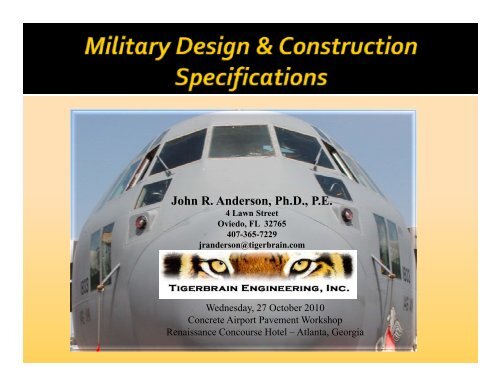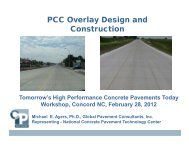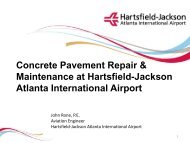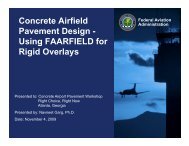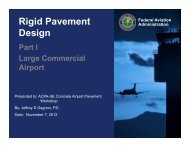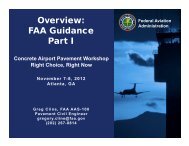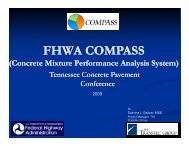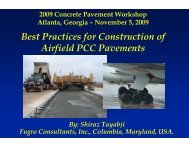John R. Anderson, Ph.D., P.E.
John R. Anderson, Ph.D., P.E.
John R. Anderson, Ph.D., P.E.
Create successful ePaper yourself
Turn your PDF publications into a flip-book with our unique Google optimized e-Paper software.
<strong>John</strong> R. <strong>Anderson</strong>, <strong>Ph</strong>.D., P.E.<br />
4 Lawn Street<br />
Oviedo, FL 32765<br />
407-365-7229<br />
jranderson@tigerbrain.com<br />
Wednesday, 27 October 2010<br />
Concrete Airport Pavement Workshop<br />
Renaissance Concourse Hotel – Atlanta, Georgia
• Design – 3 agency “policies”<br />
• Army<br />
• Air Force/Air National Guard<br />
• Navy/Marine/Coast Guard<br />
• Construction –2 agency “policies”<br />
• Army/Air Force/Air National Guard<br />
• Navy/Marine/Coast Guard
• Basic data need to know:<br />
• Agency (just discussed)<br />
• Aircraft/Airfield Type<br />
• Subgrade Strength
• Rotary Wing functions<br />
• Transport<br />
• Tactical<br />
Most Rotary Wing Airfields 6 –12 inches PCC<br />
• Airlift<br />
• Equipment<br />
• Personnel<br />
• 12 –20 inches PCC
• USAF/ANG use same standards<br />
• Base normally has one primary<br />
mission aircraft:<br />
• Fighters<br />
• Airlift/Tankers<br />
• Bombers
• Fighter<br />
• “Light Load Airfield”<br />
▪ 400,000 passes F‐15 C/D ( 68,000 lb)<br />
▪ 400 passes C‐17 (590,000 lb)<br />
• Airlift<br />
• “Medium Load Airfield”<br />
▪ 100,000 passes F‐15 E ( 81,000 lb)<br />
▪ 400,000 passes C‐17 (590,000 lb)<br />
▪ 400 passes B‐52 (400,000000 lb)
• Bomber “ Heavy Load Airfield”<br />
• 100,000 passes F‐15 E (81,000 lb)<br />
• 200,000 passes C‐17 (590,000 lb)<br />
• 120,000 passes B‐52 (480,000 lb)*<br />
*Combat Load
• Carriers/Destroyers/Subs Primary Missions<br />
• Shore‐based airfields are support/training<br />
• (a.k.a. less funding)<br />
• Navy Standard Traffic (Peace‐Time Weight)<br />
• 300,000 passes F‐14 (72,000 lb)<br />
• 150,000 passes P‐3 (135,000 lb)<br />
• 15,000 passes C‐17 (585,000 lb)<br />
• 10,000 passes KC‐10 (590,000 lb)
1. Pentagon develops War Plan<br />
2. Estimate Number of Targets<br />
3. Targets require rotary wing, fighters,<br />
bombers, UAVs<br />
4. Support / Logistics ‐ airlift/tanker missions
5. War Planners determine number of Light,<br />
Medium and Heavy Load airfields to win<br />
6. No time to rebuild airfield during war<br />
7. Therefore, life of each airfield is…<br />
“One standard war”
• Modulus of Subgrade Reaction, k, psi/in (pci)<br />
• Typically 100‐200 psi/in; outside that range is<br />
unusual<br />
• Essentially a “spring constant”<br />
• Concrete slab thickness equations based upon<br />
subgrade behaving as a “dense liquid” id” when<br />
loaded:
• HWD Best<br />
• 55,000 lb load<br />
• 200 points / day<br />
• DoD tests on<br />
5 year cycle
• CBR/k Correlations using<br />
Field or Lab CBRs<br />
• Field CBRs<br />
• Existing Pavement Only<br />
• 18 inch test pits<br />
• Several hours plus<br />
patching/cure time<br />
Field CBR in Afghanistan
• Bulk samples from multiple borings or test<br />
pits<br />
• 4‐day soak CBR<br />
• 4‐6 weeks for sampling and testing
• Agency Policies Differ<br />
• Aircraft Type<br />
• Subgrade k
• Army/Navy /Air Force use same spec<br />
• UFGS 32 13 11 www.wbdg.org<br />
• DISCONTINUED SMALL PROJECT,<br />
“LESS THAN 10,000 CY” SPEC
• ASR / Deicer / Accelerated ASR<br />
• De‐Icer / Accelerated ASR (expected to be removed from<br />
requirements pending research)<br />
• Combined / Optimized Gradation<br />
• Beam/Cylinder & w/c Correlations<br />
• Paver<br />
• Test Section
• Cement/admixture alkali+aggregate silica +<br />
water = expansive reaction<br />
Cracking after 10 years,<br />
Channel Islands, California<br />
Apron Expansion Shoves Asphalt<br />
Shoulder-damage shown required<br />
replacement every 6 months
• 0.08% maximum expansion at 28 days<br />
• FAA is 0.10% at 28 days;<br />
• ASTM C ‐1260 is 0.10% at 14 days<br />
• Considering easing based upon observed<br />
performance (Tigerbrain involved with revision)<br />
• Deicer‐ considering removing requirement<br />
based upon pending research
• Use Combined Materials<br />
• Workability and Coarseness Factors<br />
• WF: Percent Pass No. 8 Sieve<br />
• CF: 3/8 Retained % / No. 8 Retained %<br />
• Percent Aggregate Retained<br />
• 0.45 Power Curve<br />
(See also ACPA 2009 Annual Meeting Presentation )
Factor<br />
Workability<br />
45<br />
40<br />
35<br />
30<br />
25<br />
Well Graded,<br />
Minus 3/4"<br />
,<br />
Not For<br />
Paving<br />
Paving Box<br />
SIDE<br />
Rocky,<br />
DO NOT PLOT<br />
BELOW LOWER<br />
LIMIT<br />
Sandy<br />
HAND<br />
SLIP<br />
Coarse,<br />
Gap Graded<br />
20<br />
20 30 40 50 60 70 80 90<br />
Coarseness Factor
45<br />
Paving Box<br />
Sandy<br />
Wo orkability Fac ctor<br />
40<br />
35<br />
30<br />
25<br />
Well Graded,<br />
Minus 3/4",<br />
Not For<br />
Paving<br />
SIDE<br />
Rocky,<br />
DO NOT PLOT<br />
BELOW LOWER<br />
LIMIT<br />
HAND<br />
SLIP<br />
Coarse,<br />
Gap Graded<br />
20<br />
20 30 40 50 60 70 80 90<br />
Coarseness Factor
No. 100<br />
35<br />
30<br />
25<br />
20<br />
15<br />
10<br />
5<br />
0<br />
Percent Retained<br />
Combined Aggregates<br />
Percent Retained<br />
2"<br />
1 1/2"<br />
1"<br />
3/4"<br />
1/2"<br />
3/8"<br />
No. 4<br />
No. 8<br />
No. 16<br />
No. 30<br />
No. 50<br />
US Standard Sieve
100<br />
90<br />
80<br />
70<br />
60<br />
50<br />
40<br />
30<br />
0.45 Power Curve<br />
Combined Aggregates<br />
Combined Percent Passing<br />
No. 2000<br />
No. 1000<br />
No. 50<br />
No. 30<br />
No. 16<br />
No. 8<br />
No. 4<br />
2"<br />
1.5"<br />
3/8"<br />
1/2"<br />
3/4"<br />
1"<br />
20<br />
10<br />
0<br />
Sieve to 0.45 power
• Thickness based upon 90 day beam strength<br />
• Purpose: Avoid waiting 90 days for<br />
results/payment<br />
• Requires Laboratory Study Prior to Paving<br />
• Army & Air Force (Navy uses 28 day beams w/o correlations)
• 14 day : 90 day beam (or cylinder)<br />
correlations<br />
• Project specific<br />
• 6 beams @ 3, 7 , 14, 28, 90 days<br />
• 3 different w/c ratio’s (to consider climate change<br />
during production<br />
• Therefore, 90 Beams<br />
• For 14 day cylinder : 90 day beam ratio,<br />
ADDITIONAL 90 cylinders
• 7 day : 90 day used for QC<br />
• add more cement if low strength th predicted<br />
d<br />
• Still require 2 beams per lot<br />
• Correlations are extensive
• What the Owner ideally wants from the Paver:<br />
• Consolidation<br />
• Flat surface<br />
• No excess slurry/paste<br />
• Square, solid corners<br />
• Flat edges<br />
All preferably without people touching the<br />
concrete
• Central Mix on site/ample delivery fleet<br />
• Ensure paver/vibrators work<br />
• Flat pan; flat, solid slipforms<br />
• No thin, ragged, bent, torn steel<br />
• Optimize Mix to Paver<br />
• Paper / software analysis<br />
• Several 5 cy + batches in yard<br />
• Trial paving/pours before test section<br />
• Core/full depth sawcut for visual inspection
• Equipment Tigerbrain has worked with<br />
and easily meet the Paver Wants:<br />
• Gomaco<br />
• Guntert & Zimmerman<br />
• Wirtgen<br />
• Allen Form‐rider Pavers (heavy model)
• Following equipment may be possible to meet<br />
the Paver Wants, but must demonstrate<br />
process is under control to consistently meet<br />
Paver Wants:<br />
• Trusses (acceptable standard d for odd‐shaped d areas; welded d steel<br />
performs better than aluminum)<br />
• Roller Screed*<br />
• Bridge Deck*<br />
• Laser Screed* (Navy allowed on 2 projects)<br />
Laser Screed (Navy allowed on 2 projects)<br />
*Expect strong negative reaction/rejection from DoD
• Additional test batches to match mix to paver<br />
and labor<br />
• Use 3+ spud vibrators<br />
• Trial pours prior to test section<br />
• Sawcut full depth to demonstrate<br />
consolidation, ld no segregation or excess paste
After Taliban Attack, June 2010, Afghanistan<br />
(one member of escort detail survived to report; USAF flew in contractor’s<br />
backup paver)
Nighttime paving due to wind and heat; moon and artificial<br />
lights enabled mortar attacks (bad aim-no injuries)
Afternoon sandstorm moving in<br />
at MiG junkyard<br />
Haul road through<br />
thousands of Soviet-era<br />
mines on Base (marked<br />
with white painted rocks)
Gun tower<br />
Gomaco pan<br />
thin and<br />
ragged<br />
Used vibrating truss for<br />
entire 35,000 square meter<br />
apron
PCC w/ 10% silica<br />
PCC w/ 10% silica<br />
fume and<br />
superplasticizer<br />
4 meter<br />
Concrete<br />
T-Walls;<br />
deflects<br />
gunfire<br />
from bad<br />
guys
Dover AFB,<br />
Atlantic Contracting
West Virginia
West Virginia
APAC-Tennessee
AJAX-Detroit
Not Quite…
Got it!
<strong>John</strong> R. <strong>Anderson</strong>, <strong>Ph</strong>.D., P.E. 407-365-7229 jranderson@tigerbrain.com


